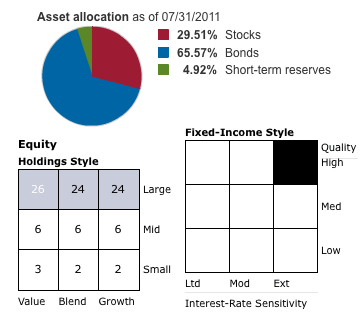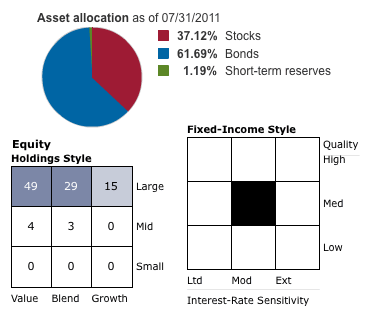There’s a ways to go, but we’re still aiming to retire within the next 10 years. As such, I’ve been thinking about what happens when we want to live off of withdrawals from our retirement portfolio. According to the passively-managed Target Date funds by Vanguard, if you reach retirement you’re directed to the Vanguard Target Retirement Income fund. Another popular option for retirees is the Vanguard Wellesley Income Fund, which has been around for over 40 years, and is actively-managed by Wellington Management Company, an advisory company that has been around since the Great Depression. Let’s take a quick look to see how these two funds compare.
Vanguard Target Retirement Income Fund (VTINX)
This fund seeks to provide “current income and some capital appreciation”. The approximate asset allocation is 30% stocks, 65% bonds, and 5% cash. It is a fund of funds, holding the Vanguard Total Bond Market II Index Fund, Vanguard Total Stock Market Index Fund, Vanguard Inflation-Protected Securities Fund, Vanguard Prime Money Market Fund, and Vanguard Total International Stock Index Fund. Here is the current asset allocation per Vanguard as well as the equity and bond style boxes from Morningstar.

Number of stocks held: 9,958 (3,323 US + 6,635 Foreign)
Number of bonds held: 4,486 (4,450 nominal bond + 36 TIPS bonds)
Expense ratio: 0.17% ($170 a year on a $100,000 balance)
Vanguard Wellesley Income Fund Admiral Shares (VWIAX)
This is an income-oriented balanced fund, which is another way of saying the same thing as above. The approximate asset allocation is 35% stocks, 65% bonds. I am choosing the Admiral shares as opposed to the Investor shares because the great majority of people using this for their retirement will reach the $50,000 minimum balance. Here is the current asset allocation per Vanguard as well as the equity and bond style boxes from Morningstar.

Number of stocks held: 60
Number of bonds held: 559
Expense ratio: 0.21% ($210 a year on a $100,000 balance)
Commentary
The overall asset allocation of the two funds is very similar, especially since you could consider cash/short-term reserves as bonds. However, how they are constructed is very different. Target Retirement is passively indexed on a market-cap weighted distribution and holds nearly 10,000 stocks from around the world. Wellesley is actively-managed to include only 60 selected dividend stocks from primarily large, US companies.
As for bonds, Target Retirement follows another market-weighted index of the Barclays Capital U.S. Aggregate Float Adjusted Bond Index. There is a large chunk of US Treasury, US Treasury Inflation-linked, and US Agency mortage-backed bonds. Wellesley is mostly in corporate investment-grade bonds.
Wellesley is produces more of it’s returns as income through stock dividends and the higher bond yields from corporate bonds, with a current SEC yield of 3.28%. This allows the psychological benefit of possibly spending only the dividends that the fund distributes every quarter. However, there is the concern that 60 stocks is not enough diversification, or that their bond analysts might drop the ball. Here is the growth chart of $10,000 (click to enlarge):
At least historically, the managers of Wellesley have added value. Will it continue? Unknown. The good news is that with such low costs, there’s one less reason to expect underperformance in the future. These are just an example of what is out there, although on some early retirement forums I see folks simply holding a 50/50 split of these two exact funds. Sometimes I think everyone should just start with these kind of low volatility funds in the first place, and just reinvest dividends.

 The Best Credit Card Bonus Offers – 2025
The Best Credit Card Bonus Offers – 2025 Big List of Free Stocks from Brokerage Apps
Big List of Free Stocks from Brokerage Apps Best Interest Rates on Cash - 2025
Best Interest Rates on Cash - 2025 Free Credit Scores x 3 + Free Credit Monitoring
Free Credit Scores x 3 + Free Credit Monitoring Best No Fee 0% APR Balance Transfer Offers
Best No Fee 0% APR Balance Transfer Offers Little-Known Cellular Data Plans That Can Save Big Money
Little-Known Cellular Data Plans That Can Save Big Money How To Haggle Your Cable or Direct TV Bill
How To Haggle Your Cable or Direct TV Bill Big List of Free Consumer Data Reports (Credit, Rent, Work)
Big List of Free Consumer Data Reports (Credit, Rent, Work)
Is the chart above taking into account dividend reinvesting? If I just look at the growth of these two stocks since VTINX inception it looks to have outperformed VWIAX.
Yes, the growth $10,000 shows the effect of reinvesting dividends and thus takes into account total return and not just change in share price.
I recently just found out that Vanguard even had actively managed funds (I am not a customer). I wonder how many customers have no clue about the actively managed funds…and how well some do.
Isn’t it hypocritical for Vanguard to have actively managed funds?
Well, I guess 0.21% is very low. So should Bogleheads really be emphasizing low cost funds rather than index funds? Just hypothetically, if there was an index fund that was 0.50% vs active fund that was 0.25% that are in the same asset class, then the active fund should do better.
Vanguard is more based on the concept of “at-cost” investing, meaning they try to pass on any cost savings onto the clients instead of shareholders. I think people should try to understand *why* index funds are better than most actively-managed funds, and high costs are a huge part of that. There are other factors like stock turnover leading to tax inefficiency, transactional costs from trading including commissions and bid/ask spreads, manager risk, etc.
There are many index funds with high costs, and even some “enhanced” index funds with high costs, that I would definitely avoid. I would actually prefer a low-cost active fund run properly vs. an expensive index fund.
Not only that, but for Vanguard, its clients *are* its shareholders. Vanguard, the company, is owned by the Vanguard funds themselves, which are in turn owned by its clients. So the investors truly “come first”, since they’re the only one to which Vanguard has to answer. Promoting at-cost investing is built into the very fabric of the company ownership structure.
I would say at this point “and no one pays me to say that, I’m just a satisfied customer”, but then again, as a client, I do own something like 0.000001% of the company.
Well, I wouldn’t go that far as to consider myself a shareholder even though I agree the structure is that the funds own the company, just because I don’t get any voting rights or any say as to the salaries of the executives or how things are run. Vanguard is still in it to make money and grow, as their greatly increased advertising budgets attest to (which comes out of fund expenses, but may lead to overall lower expenses on a percentage ratio).
I agree that the stocks in a retirement income fund should tilt towards dividend payers. However, there isn’t really a need to go to the extreme of holding only 60 stocks. Why not brew your own and tilt the stocks the way you want using VHDYX, the Vanguard High Dividend Yield Index Fund? It owns 430 stocks.
The question for VTINX is what is the total expense ratio. The fund does advertise 0.17% expense ratio but is that just for the VTINX or does it include the expense ratios for the underlying funds. I have a tough time getting my head around that one. If the underlying funds are charging their expense ratios the overall expense (even for Vanguard) could be double the 0.17% expense ratio identified. Maybe someday I will read one of the prospectuses when I cant sleep. Any thoughts.
@Girish – The expense ratio for all Vanguard Target funds are simply the weighted average of the underlying funds. Vanguard does not charge an extra layer of fees on top of the underlying funds, although some other fund companies do.
You may want to read a book by Alexander Green entitled “The Gone Fishing Portfolio”. It uses 10 Vanguard funds to consistently provide good returns, with no yearly trading and a once a year rebalancing strategy. This is an an award winning strategy for minimizing volatility, maximizing returns, and sets you free to Go Fishing. I hve been doing it for the last few years and it has worked quite well compared to the market.
@Jim – That is also a good indexed suggestion, with an ETF version. For active management, I also found Vanguard Equity Income fund with 200+ stocks. I don’t know much past that, but it’s another dividend oriented fund run by Wellington.
It’s funny that everyone has a better way. Wellesley has averaged a return of over 10% over the past 41+ years and that includes the stagflation of the 70’s and early 80’s that makes our recession look tame. So, if you think you’ve got a better way, go for it, but I’m getting a great return on very low volatility from managers that have stuck to a proven method with good discipline.
i’m paying a guy in fidelity .80%/yr to manage my money – i told him he needed to beat my benchmark of the average of 50/50 wellsley and wellington; at almost 70 yo i’m conservative – it has been over 6 qtrs and he is not close – i like him but when i get the nerve he’s gone…both funds are successful for decades and the wellsley has a .60 beta pr so – why do i need anything else except some cash n the side, why?
Vanguard has lowered the expense ratio of the WELLESLEY Income Fund Admiral shares (VWIAX) to 0.18%.
Does vanguard lower that cost to .18 as soon as one reaches the 50,000 balance in that Wellesley Fund?
Yes, I believe they automatically change you over to the admiral shares eventually if you stay above $50,000.